You have just completed a remodeling or new construction project. Now, you realize the construction wasn’t the bigger challenge. Disposing of the debris, especially broken concrete, is the dilemma.
With concrete debris, you have two options. You can dispose of it using junk removal service providers such as Junk King. Or, you can reuse the concrete in your yard. Of course, reusing concrete is the cheaper option.
The importance of recycling concrete
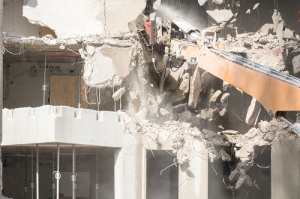 Recycling concrete has the following advantages:
Recycling concrete has the following advantages:
- Reduction of construction waste
- Extending the life of landfills
- Saving on disposal costs
You may not care for the environment, but you definitely care about saving money. Hauling concrete is quite expensive, especially considering the process might require large trucks and several trips. Besides, reusing it in a landscaping project adds value to your property.
So, how exactly can you reuse concrete in your yard? Consider the following recycled concrete projects.
Patio decoration
Can your patio use a new look? Consider decorating it with broken concrete. You can arrange pieces of concrete around your patio in whatever pattern you want.
Decorating with concrete debris doesn’t apply to patios only. You can use the pieces to form a border around your lawn, flowerbed, or any other relevant area in your yard.
What if you don’t like the rustic look of concrete? You can give your pieces a fresh look with concrete stain. For uniformity, most landscapers prefer one color. But different colors can make your patio the highlight of your yard.
Raised planter or flowerbed
A raised garden improves drainage. Also, it makes provides better access to gardeners with limited mobility, such as the elderly. Additionally, since the oil is above the ground, it becomes warmer, which encourages faster germination.
Using concrete debris, you can raise a garden to 3 feet above the ground. First, select pieces of concrete that are almost the same size. Then, dog a foundation of about six inches. Fill about 2 inches of your trench with sand. Then start stacking the pieces of concrete together to form a wall. The purpose of the foundation is to ensure the garden does not shift even during small earthquakes.
For a more appealing finish, make sure the smoother edges of the broken concrete face outward.
Retaining walls
You can use concrete debris to build a retaining wall. Of course, you will save money by recycling your concrete waste. Another advantage is that the old pieces will provide a rustic look that’s difficult to achieve using fresh concrete.
Moreover, a retaining wall could be big enough to use up all your concrete debris. So, you could cut the concrete waste hauling costs to zero.
Walkways
Concrete debris is perfect for walkways since they do not experience the heavy traffic of driveways. Plus, it is an excellent choice for walkways as it resembles flagstone.
Walkways help define pathways to different areas and spaces in your yard. For instance, a walkway to your patio will make people stop stepping on your lawn anyhow.
All you need to do is lay down the concrete pieces in a desirable pattern. However, if the pieces are too large, you might have to hire specialized equipment to reduce the size. Also, for more durability and stability, dig the area and form a foundation of sand and gravel before placing the broken piece of concrete.
Safely dispose of concrete waste
If any of the above landscaping projects are an option, go ahead and reuse concrete. But, if it’s impractical for you to reuse the concrete debris, be sure to dispose of it safely.
Junk King provides excellent construction waste disposal services. A good reason for using our services is that we recycle most of the concrete we collect. More importantly, the company has the necessary equipment and staff well-trained to handle the collection of broken concrete. Contact for more information.
 Text Us
Text Us




 Construction waste includes concrete, wood, steel, glass, nails, shingles, and so on. Moving some of these objects can be dangerous. Sharp items can cause cuts and abrasions while heavy-lifting of rubble can lead to back strains.
Construction waste includes concrete, wood, steel, glass, nails, shingles, and so on. Moving some of these objects can be dangerous. Sharp items can cause cuts and abrasions while heavy-lifting of rubble can lead to back strains. You’re unlikely to have as big a problem as the
You’re unlikely to have as big a problem as the  Here’s a junk-related question for you. What image springs to mind when you hear the phrase “debris removal?” Most people immediately think of trash pickup, but there are
Here’s a junk-related question for you. What image springs to mind when you hear the phrase “debris removal?” Most people immediately think of trash pickup, but there are  With these combined efforts, authorities have been making tremendous strides in reducing the 22 million tons of waste that is generated every year in the US, however, further reducing that number greatly depends on responsible waste management from the average household to the industrial level.
With these combined efforts, authorities have been making tremendous strides in reducing the 22 million tons of waste that is generated every year in the US, however, further reducing that number greatly depends on responsible waste management from the average household to the industrial level.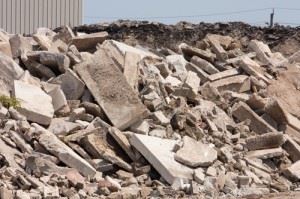
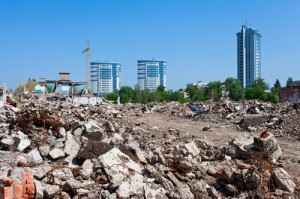
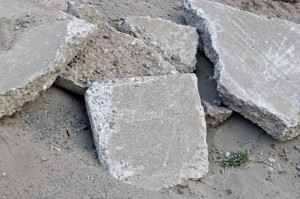 Let’s say you’ve just finished doing some renovations to the landscaping in your front or backyard and you now have a bunch of broken concrete chunks lying around the premises. Should you have them hauled away or can you figure out a way to turn an eyesore into something attractive and/or useful? Having it hauled away may not be the most ecologically sound thing to do because you know where it’ll likely end up, yet getting a little creative with these excess chunks of urbanite (concrete from the city?) may add some flare and additional curb appeal to your home.
Let’s say you’ve just finished doing some renovations to the landscaping in your front or backyard and you now have a bunch of broken concrete chunks lying around the premises. Should you have them hauled away or can you figure out a way to turn an eyesore into something attractive and/or useful? Having it hauled away may not be the most ecologically sound thing to do because you know where it’ll likely end up, yet getting a little creative with these excess chunks of urbanite (concrete from the city?) may add some flare and additional curb appeal to your home.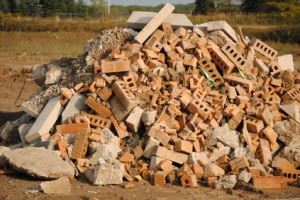 Construction waste includes a variety of the different materials left over from remodeling or renovating homes, businesses, or public recreational areas. Often times these materials can be considered hazardous or toxic, whether coming from your home, yard, or various construction sites in the immediate area.
Construction waste includes a variety of the different materials left over from remodeling or renovating homes, businesses, or public recreational areas. Often times these materials can be considered hazardous or toxic, whether coming from your home, yard, or various construction sites in the immediate area. If you are looking for a junk hauler to tackle every type of job, no matter how big, small or complex, look no further. Junk King is here to help you clear out your junk, whether it is yard waste, old appliances, furniture or just about anything else. Hauling is our business and we do it in the most environmentally responsible way possible.
If you are looking for a junk hauler to tackle every type of job, no matter how big, small or complex, look no further. Junk King is here to help you clear out your junk, whether it is yard waste, old appliances, furniture or just about anything else. Hauling is our business and we do it in the most environmentally responsible way possible.